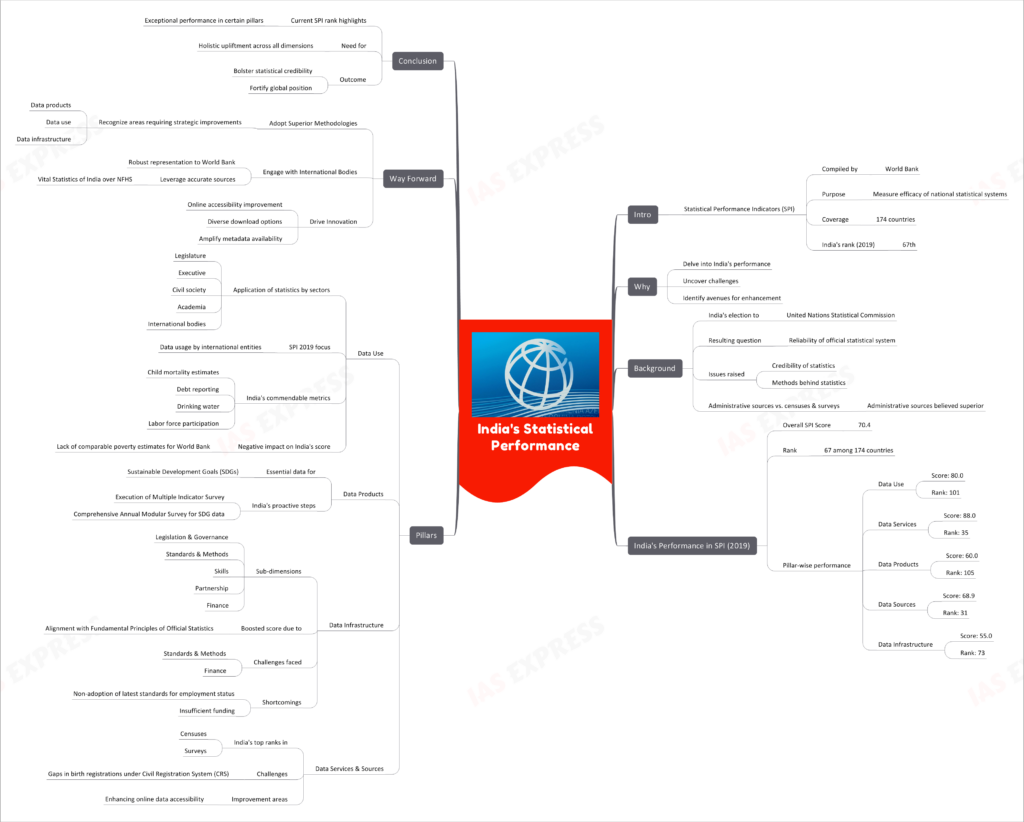India’s Statistical Performance- What does the SPI tell us?
From Current Affairs Notes for UPSC » Editorials & In-depths » This topic
IAS EXPRESS Vs UPSC Prelims 2024: 85+ questions reflected
The Statistical Performance Indicators (SPI) compiled by the World Bank serve as a benchmark to measure the efficacy of national statistical systems across 174 countries. With India securing the 67th rank in 2019, there emerges an urgent need to delve into its performance, uncover the challenges, and identify avenues for enhancement.

Background
- India’s election to the United Nations Statistical Commission brings the reliability of its official statistical system under a lens.
- The credibility and methods behind the statistics it produces are in question.
- Comparatively, administrative sources are believed to offer superior data quality than censuses and surveys, a fact that warrants examination.
Overview of SPI & Its Dimensions
The World Bank’s SPI evaluates the performance of national statistical systems based on five critical pillars:
- Data Use
- Data Services
- Data Products
- Data Sources
- Data Infrastructure
India’s Performance in SPI (2019)
- Overall SPI Score: 70.4
- Rank: 67 among 174 countries
- Pillar-wise Performance:
- Data Use: Score – 80.0, Rank – 101
- Data Services: Score – 88.0, Rank – 35
- Data Products: Score – 60.0, Rank – 105
- Data Sources: Score – 68.9, Rank – 31
- Data Infrastructure: Score – 55.0, Rank – 73
Deep Dive into the Pillars
1. Data Use
- Pertains to the application of statistics by sectors like legislature, executive, civil society, academia, and international bodies.
- SPI 2019 only focused on data usage by international entities.
- India showcased commendable performance in metrics like child mortality estimates, debt reporting, drinking water, and labor force participation.
- However, the unavailability of comparable poverty estimates for the World Bank in the past decade negatively affected India’s score.
2. Data Products
- Revolves around essential data required for Sustainable Development Goals (SDGs).
- India’s proactive steps include the execution of the Multiple Indicator Survey and Comprehensive Annual Modular Survey to gather SDG data.
3. Data Infrastructure
- Comprises sub-dimensions like Legislation & Governance, Standards & Methods, Skills, Partnership, and Finance.
- India’s impressive alignment with the Fundamental Principles of Official Statistics boosted its score.
- Yet, challenges in Standards & Methods and Finance affected the overall performance.
- Shortcomings include non-adoption of latest standards for classifying employment status and insufficient funding.
4. Data Services & Sources
- India stands out in censuses and surveys, achieving top ranks.
- Yet, administrative data scores suffer due to gaps in birth registrations under the Civil Registration System (CRS).
- Enhancements in online data accessibility could further propel India’s rank.
Way Forward
- Adoption of Superior Methodologies: Recognize areas like “Data products”, “Data use”, and “Data infrastructure” that require strategic improvements.
- Engage with International Bodies: A robust representation to the World Bank is essential. Leveraging more accurate sources like “Vital Statistics of India” over the NFHS could rectify discrepancies in SPI evaluation.
- Drive Innovation: Improving online accessibility, offering diverse download options, and amplifying metadata availability can further optimize the statistical system.
Conclusion
While India’s rank in SPI underscores the nation’s exceptional performance in certain pillars, a holistic upliftment across all dimensions is imperative. Such an endeavor will not only bolster India’s statistical credibility but also fortify its position on the global stage.
Practice Question for Mains
In view of India’s election to UN Statistical Commission, evaluate the country’s statistical performance. What needs to be done? (250 words)
If you like this post, please share your feedback in the comments section below so that we will upload more posts like this.

